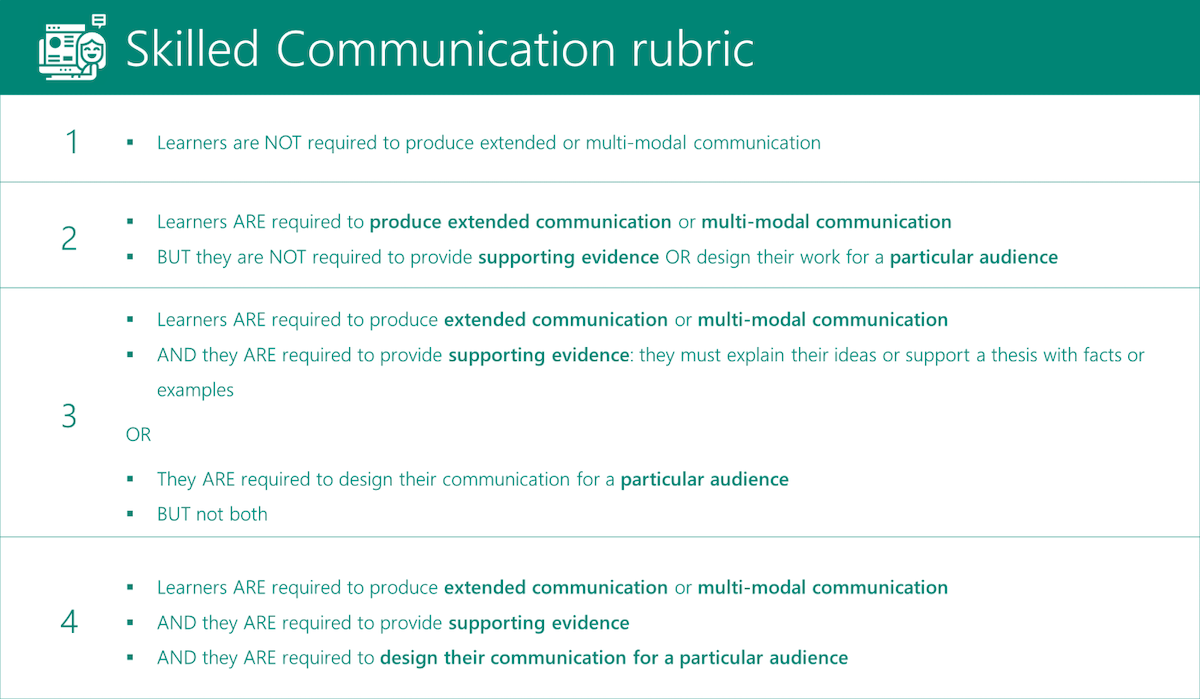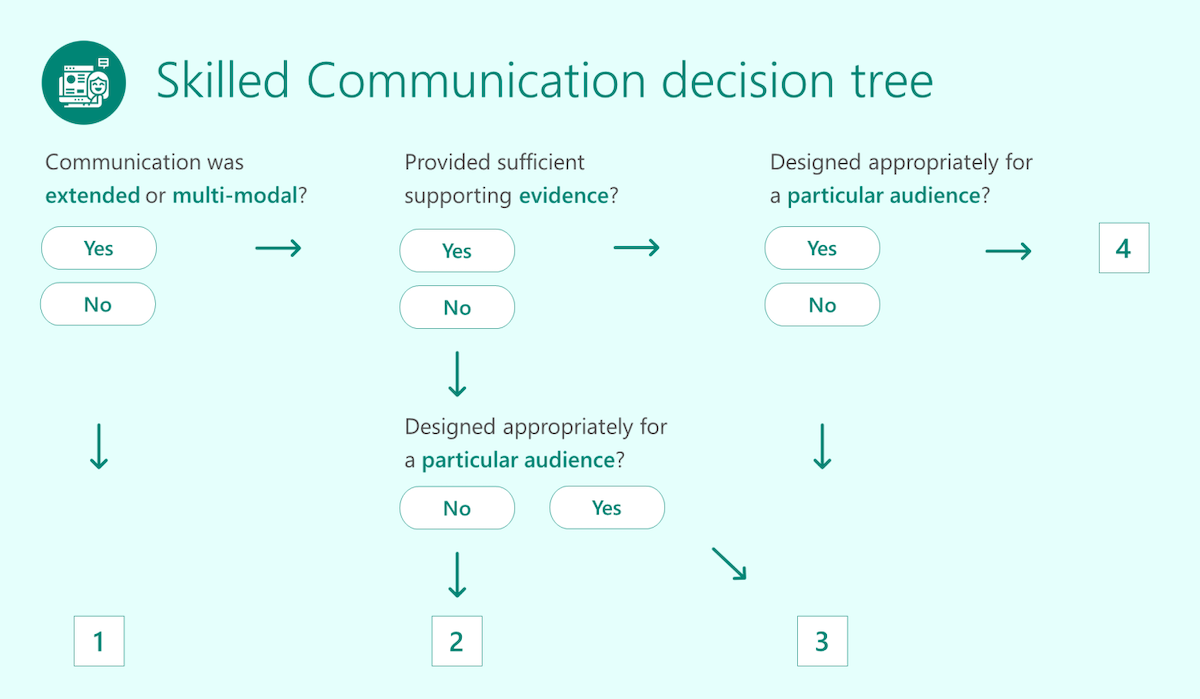Design learning experiences with the skilled communication rubric
The 21st century learning design (21CLD) skilled communication rubric examines whether learners produce extended or multimodal communication. At a deeper level, it explores whether learners substantiate their communication with a logical explanation, examples, or evidence that supports a central thesis. At its deepest level, learners must craft their communication for a particular audience.
The 21CLD skilled communication rubric captures the big ideas of skilled communication and is a useful framework when designing learning activities. The levels of skilled communication (one to four) in the rubric are:

Go to Rubric – Skilled Communication for an accessible version of the rubric.
The skilled communication decision tree is a visual representation of the big ideas in the dimension. It consists of a series of three questions that educators must consider when designing learning activities to deepen skilled communication:
- Is the communication extended or multimodal?
- Does the communication provide sufficient supporting evidence?
- Is the communication designed appropriately for a particular audience?

Go to Decision Tree – Skilled Communication for an accessible version of the decision tree.
This 21CLD dimension requires learners to practice their communication skills. 21st century skilled communication takes many different forms. In this rubric, however, we don't focus on informal discussions, whether face-to-face or electronic. Instead, we focus on activities that require learners to articulate their ideas in a permanent form such as a(n):
- Presentation
- Podcast
- Written document
- Performance
- Skit
- Debate
Less formal conversation media are also important aspects of communication. However, for informal communications like a video call to qualify in this rubric, they'll need to have an outcome related to the learning goals of the activity. For example, do learners produce a summary of what they've learned through the video call or build that learning into the final products they create? Therefore, the skilled communication rubric evaluates the requirements of the product or outcomes of the learners' work and asks:
Is the communication
- Extended?
- Multimodal?
- Substantiated?
- Designed with a particular audience in mind?
Is the communication extended or multimodal?
With the first question, the communication may be either extended or multimodal.
Extended communication is when learners must produce communication that represents a set of connected ideas rather than a single simple thought. In written work, extended communication is the equivalent of one or more complete paragraphs. In an electronic or visual media work, extended communication may be:
- A sequence of video
- A podcast
- A slide of a presentation that connects or illustrates several ideas
However, a single text message or a tweet isn’t extended communication. Electronic communication qualifies as extended only if it produces an outcome that requires learners to connect the ideas they have discussed. The duration of an electronic chat is irrelevant in evaluating extended communication.
The following scenarios don't require extended communication:
- Learners participating in a webinar where they listen to presentations by peers from a sister city and asking follow-up questions
- Learners solving a geometry problem but not writing a proof
- Learners posting a one-sentence comment in response to a recent news article of their choice
- Learners holding a video call with peers from another school to talk about a novel they’ve read
The following scenarios require extended communication:
- Learners hosting a webinar to present on different topics about their city to peers in a sister city and answering follow-up questions
- Learners writing an extended proof to demonstrate the solution to a geometry problem
- Learners writing a letter to the editor in response to a recent news article of their choice
- Learners holding a video call with peers from another school to create a plan for a joint performance on a novel they’ve just read
Multimodal communication includes more than one type of communication mode or tool used to communicate a coherent message. For example, learners might create a presentation that integrates video and text or embed a photograph into a blog post. However, the communication qualifies as multimodal only if the elements work together to produce a stronger message than any one element alone. Additionally, if the learning activity allows learners to choose the tool or tools they'll use to communicate, it’s a multimodal communication opportunity.
The following scenarios aren't multimodal communications:
- Learners creating a radio advertisement for their invention. The learning activity doesn’t offer learners any choice regarding the type of media.
- Learners writing lab reports about their science lab on density of matter using only narrative text.
- Learners producing a podcast on a hurricane for their journalism class by writing a script with which to record the audio podcast. The story is the same whether written out (in the script) or spoken (in the podcast).
The following scenarios are multimodal communications:
- Learners creating a print, radio, or television advertisement for their invention. The educator designed the activity to allow learners choose what type of media they wish to use.
- Learners writing lab reports about their science lab on density of matter, including narrative text and visual evidence of what the learners saw in their experiment (such as drawings or screenshots of real time data displays). The activity requires multiple modes of media that work together for a more complete description of the experiment.
- Learners producing blog posts on a hurricane for their journalism class, including a written description of the conditions and additional audio or visual media. The activity requires multiple modes of media to add depth to the learners' descriptions.
Does the communication provide sufficient supporting evidence?
Communication requires supporting evidence when learners must explain their ideas or support their thesis with facts or examples. The evidence must be sufficient to support the claim that the learner is making. In this instance, a thesis is a claim, hypothesis, or conclusion. Learners must have a thesis when they:
- State a point of view
- Make a prediction
- Draw a conclusion from a set of facts or a chain of logic
The following scenarios don't require supporting evidence:
- Learners writing an essay about global warming. They may complete this activity with a set of facts. They don't have to state and support a claim, hypothesis, or conclusion.
- Learners deriving a mathematical equation and computing the equation without explaining their logic.
- Learners writing a blog post listing the main themes in Alice in Wonderland.
- Learners writing a journal entry from the perspective of a slave. They must describe their day with historical accuracy, but they don’t state or support a perspective about their imagined life.
- Learners using Flip to video themselves solving a mathematical problem and stating the steps they took. They don’t narrate their reasoning process.
The following scenarios do require supporting evidence:
- Learners writing an essay about why global warming is a problem. They must state and defend a claim about global warming.
- Learners describing their derivation of a mathematical equation and explain the logic that brought them to this conclusion.
- Learners writing a blog post about the main themes from Alice in Wonderland with examples from the story to illustrate their point.
- Learners writing a journal entry from the perspective of a slave. They must state a perspective or a point of view about their imagined life and describe their day with historical accuracy to support that perspective.
- Learners using Flip to video themselves solving a mathematical problem, including both the steps they took and their reasoning.
Is the communication designed appropriately for a particular audience?
At its deepest level, skilled communication requires learners to ensure their communication is appropriate to the specific readers, listeners, viewers, or those with whom they’re communicating. It’s not enough for learners to communicate to a general audience such as the Internet. They must have a specific group with specific needs in mind to shape their communication appropriately. When they communicate with a particular audience, learners must select the tools, content, or style they'll use to reach that specific audience. They must consider:
- What tools the audience has access to or will use regularly
- The relevant information they need to present for their audience to understand their thesis
- The formality or informality of the language appropriate for the specific audience
To qualify for this level of skilled communication, the learning activity may specify a particular audience, or learners may select their own audience. It's ideal, but not essential or always possible, for the audience to see the communication.
When designing learning activities, the requirement is that learners must develop their communication with that audience in mind. For example, learners may develop some type of activity to teach younger children how to divide fractions. They'll decide what medium to use to reach those learners, such as a podcast or a game. Additionally, they must also consider what type of language and content the children would understand and relate to. This satisfies the requirement even if the younger learners never use the podcast or the game. Many educators find it useful to specify an audience of a different age or background than the learners themselves. This highlights the need to think about:
- The audience they’re communicating with
- What they'll and won’t understand
- What they might find interesting
The following scenarios aren't designed for a particular audience:
- Learners creating a video about their school using appropriate imagery and evidence, but with no specified audience
- Learners writing an essay about their ideas for improving a particular product
- Learners completing a "rocks and minerals" science project. The learning activity requires them to communicate a central finding, include rock and mineral samples, narrative text and/or audio information, but the educator is the only one who will see it.
The following scenarios are designed for a particular audience:
- Learners creating a video about their school, using appropriate imagery and evidence, to welcome incoming learners
- Learners writing a letter to a company suggesting improvements to a product, considering the arguments and perspectives that will be most compelling to that company
- Learners designing a "rock and minerals" exhibit for the town library. The learning activity requires them to communicate a message through the exhibit, which must include samples, different media to capture visitor interest, and take-home pamphlets for visitors
Now, practice coding one of the anchor lessons in the 21CLD OneNote notebook by doing the following:
- Review the Growth Mindset learning activity page.
- Consult either the skilled communication rubric or decision tree and code the lesson
- If working with colleagues during this module, discuss your findings
- Refer to the video to compare your analysis with Becky's explanation in the following video:
Bonus: To better prepare for the Microsoft Certified Educator Exam, practice coding more anchor lessons. Suggested activities in the anchor lesson section:
- Doing Business in Birmingham
- Design a Catapult
- Indigenous Cultures
When you finish coding the lesson, review the coding results summary in the anchor lesson section to compare your findings to others.